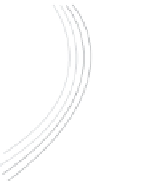Biomedical Engineering Reference
In-Depth Information
Macula lutea
Temporal retinae
Nasal
retinae
Optic nerve
Optic chiasma
Optic tract
Lateral geniculate body
Optic
radiations
Visual area
in occipital
lobe of cerebrum
FIgUre 10.9
(See color insert.)
The optic chiasm and the optic nerves and their pathway.
A short closing remark. What has been described here is the so called retino-geniculate
cortex pathway. However, not all of the fibers rising from the optic nerve follow this path.
Approximately 20% follow a retino-collicular-cortical path, involved in space localization.
However, this particular kind of fiber does not permit identification of the object and is
apparently responsible of the blind-sight phenomenon.
10.2.2 The Visual Abilities in Behavioral Optometry
The precedent description underlined that the visual process is something much more
complex than a good visual acuity. The well-known 10/10 (20/20 in the United States, 6/6
in the United Kingdom) represents just one among the visual abilities, which is not even
the most important one, although this parameter is usually used to distinguish those hav-
ing a good sight from those who do not. In this section, object of analysis will be the main
visual ability that must be assessed in patients who require assistive technology (Bardini
1982; Birnbaum 1985, 1993; Sabbadini et al. 2000).
10.2.2.1 Visual Acuity
Visual acuity represents the ability to recognize two points as separate, and it is mainly
conceived as an angular measurement. It does not directly indicate the dimension of the
object, the details of which can be recognized, but only their angular dimension. Under
the same visual acuity, the dimensions are modified by distance (Figure 10.10).
Visual acuity is not only an indication of the correct focus of the eye's optical system, but
it is also a consequence of the transparency of the means, not to mention the integrity of
the nerves and of the superior cortical areas.








































